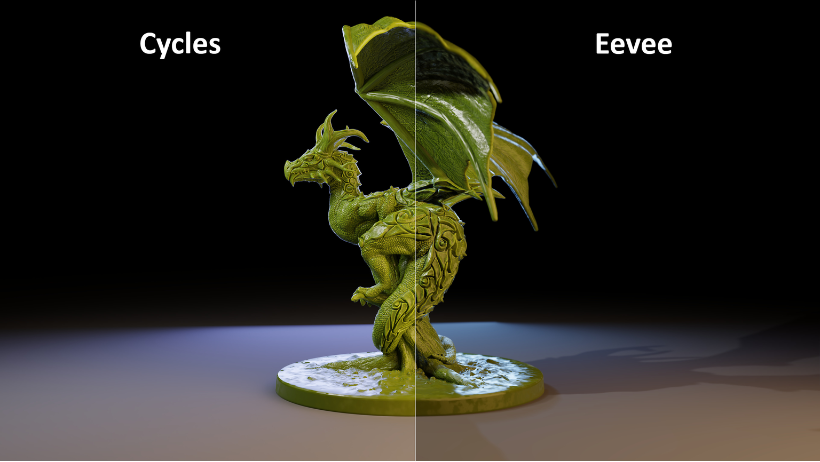When working in Blender, one of the first decisions you’ll need to make is choosing the right render engine: Cycles or Eevee. Both are powerful and versatile, but each serves a distinct purpose depending on your goals, desired visual quality, and deadlines.
In this article, we’ll compare the two engines in detail, highlight their strengths and limitations, and help you decide which one is best for your project. Finally, we’ll introduce a smart solution to speed up your rendering process: 3S Cloud Render Farm.

What Is Cycles?
Cycles is Blender’s physically-based path tracing engine. Unlike rasterization engines, it simulates real-world lighting with high accuracy. As a result, it delivers photorealistic images with precise shadows, reflections, and lighting behavior.
Key Features of Cycles:
- Physically accurate lighting and materials, ideal for realism
- Realistic shadows, caustics, and reflections for lifelike results
- Supports both CPU and GPU rendering, depending on your setup
- Full compatibility with render passes and Blender’s compositor
- Preferred for high-quality stills and cinematic animations
Best Use Cases:
- Architectural visualization with detailed interiors and lighting
- Product design that requires lifelike materials and textures
- VFX shots where realism and lighting accuracy are essential
- Close-up renders with fine lighting control
Limitations:
However, Cycles is not without challenges. It is relatively slower than Eevee and requires significant computing power, especially for animations or large scenes. Consequently, it may not be suitable for tight deadlines or low-end machines.
What Is Eevee?
On the other hand, Eevee is Blender’s real-time render engine, designed for speed and interactivity. While it doesn’t offer the same level of realism as Cycles, it produces high-quality results fast—making it ideal for certain workflows.
Key Features of Eevee:
- Real-time rendering, allowing for instant feedback in the viewport
- Supports modern effects like bloom, motion blur, and depth of field
- Features screen-space reflections and ambient occlusion
- Compatible with most Blender materials and shaders
- Lightweight and fast, even on modest hardware setups
Best Use Cases:
- Stylized and NPR (non-photorealistic) animations
- Motion graphics, where rendering speed is a priority
- Game asset previews and quick turnarounds
- Concept art and look development for 3D scenes
Limitations:
That said, Eevee uses rasterization techniques and approximates lighting, which can lead to less accurate shadows and global illumination. Therefore, it may not be the best option when realism is your top priority.
Cycles vs. Eevee: Feature Comparison
To make the choice clearer, here is a quick side-by-side comparison:
| Feature | Cycles | Eevee |
|---|---|---|
| Render Type | Path-traced (realistic) | Rasterized (real-time) |
| Performance | Slower, resource-intensive | Fast and responsive |
| Realism | High, physically accurate | Moderate, stylized |
| Lighting & Shadows | Dynamic and fully accurate | Approximate and screen-based |
| Best For | Final renders, realism | Previews, animation, stylization |
How to Choose Between Cycles and Eevee
Ultimately, the choice between Cycles and Eevee depends on your specific needs.
If your project demands photorealism, accurate reflections, and complex lighting, then Cycles is the better option. It may take longer to render, but the results speak for themselves.
Conversely, if you need speed, real-time responsiveness, or you’re creating stylized visuals, Eevee can significantly improve your productivity. You can preview scenes instantly and make quick adjustments without waiting for lengthy renders.
In many cases, artists start with Eevee during the development phase and switch to Cycles for final rendering. This workflow offers the best of both worlds—fast iteration and high-quality output.
>>> Read more: Understanding Render Engines in Blender: Eevee vs. Cycles
Boost Your Rendering Speed with 3S Cloud Render Farm
Regardless of whether you choose Cycles or Eevee, rendering complex scenes or long animations can slow down your production, especially on personal hardware. That’s why many creators turn to 3S Cloud Render Farm for a smarter rendering solution.
Why Use 3S Cloud Render Farm:
- Access to high-performance GPU and CPU render nodes
- Fully supports Blender, including both Cycles and Eevee
- Simple drag-and-drop interface for fast project uploads
- Real-time render tracking and scene syncing
- Pay-as-you-go pricing with no monthly commitment
- 24/7 technical support for troubleshooting and guidance
By offloading your rendering to the cloud, you can save time, reduce stress, and focus on your creative work rather than your hardware limitations.
Conclusion
In summary, Cycles and Eevee each offer distinct advantages depending on your project’s goals. Use Cycles for realism and high-quality detail, and choose Eevee when speed and efficiency are more important.
No matter which engine you choose, 3S Cloud Render Farm is here to help you bring your Blender projects to life—faster and more efficiently. With powerful render nodes, Blender-native support, and flexible pricing, it’s the perfect companion for any artist looking to scale up production without investing in costly hardware.
